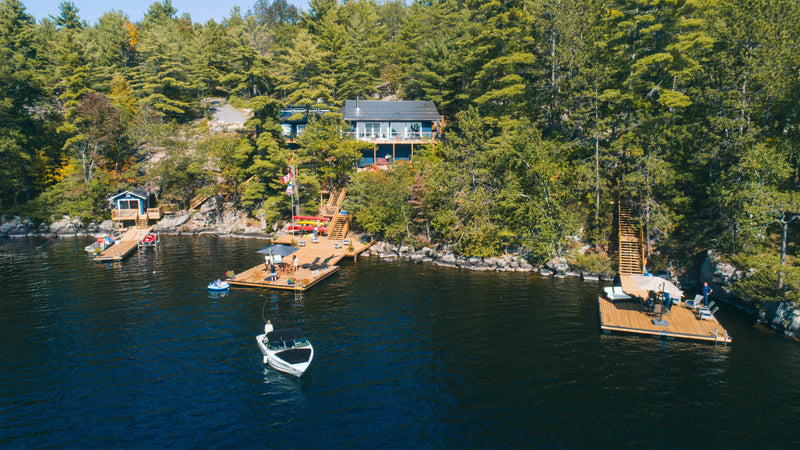What special tools are required for the Do-It-Yourselfer?
None. A NyDock can be assembled using common hand tools that any do-it-yourselfer already has.
Can the dock be installed, or can I do it myself?
You can purchase a complete NyDock package and have it delivered and installed onto your shoreline by AK Outdoors. Alternatively, you can buy the pontoons and build your own dock.
How do I know what type of installation is best for me, on my property?
Every situation on every property is slightly different. If necessary, we can provide an on-site consultation to review your needs for a nominal fee. If you decide to purchase a dock from us, the consulting fee will be waived and we can design a dock and land assembly plan tailored particularly for your specific property and waterfront.
What should I know before I build and install a NyDock?
Many factors need to be considered when designing, building and installing a dock. These include dock size limitations, local or provincial rules and regulations or building materials allowed. Contact your local Ministry of Natural Resources, local building department and the Department of Fisheries and Oceans for building guidelines.
Is there any risk at all in leaving them in the water over the winter?
Maybe. It does not hurt the pontoons or affect the docks to be frozen into the ice over the winter. However, you need to be aware of the history of typical ice movements on your shoreline during the spring break-up. If significant bodies of ice from the lake are known to move into your shoreline during the break-up, then your dock should be disconnected and pulled to a protected area or cove for the winter. But it does not need to come out of the water and is easily towed by a boat. If your shoreline is deemed to be a risky area during the break-up, this safeguard will avoid possible damage from the massive force of moving ice which can destroy almost anything.
Can the NyDock be left in the water over the winter?
Yes. The NyDock is not affected by winter ice. Most people disconnect their access ramp and tie the dock back to shore for the winter. The weights are left connected to the main dock and everything remains in place. The dismantling process takes about 5 minutes.
Can I reconfigure or move the NyDock?
A NyDock can be moved by simply untying it from its concrete anchors and repositioning it elsewhere. For example, it can be towed to a deeper part of your lake and used as a swimming raft. Also, if your NyDock has a transom, it can be used as a pontoon boat.
How high does the NyDock sit out of the water?
The top of the deck on an 8’ wide dock sits about 17” above the water level when it is empty whereas a 12’ wide dock sits about 16” out of the water.
How stable is a NyDock?
Two concrete weights weighing 330 pounds each are placed in the water on the outboard end of the dock.The weights are connected to the dock by 5/8” thick marine grade floating rope. The ropes can be easily accessed through removable access ports on the deck. Adjustments for changes in water levels can be easily made in areas affected by water fluctuations.
How do I attach the NyDock to my shoreline?
We offer access ramps which have hinges on both sides and a float on one end. One end of the ramp connects to a platform on your shoreline and the other end to your dock. The float on the end of the ramp takes all of the weight off of the dock and adds to the overall stability.
What is the maximum length and width of a NyDock?
Typically, two 18” pontoons are used which allows widths from 8’ to 12’. If you want to go wider, say 16’, you will need to add a third pontoon. Since the length of the pontoons is usually equivalent to the decking length, there is no maximum length. However, if you wish to build a dock longer than 24’, you should consult us for technical details.
What type of construction do you use to build the NyDock?
We use 2” x 6” lumber for the stringers and decking. A 2” x 10” fascia is used to complete the product, which provides a nice flat finished face around the perimeter of the dock.
How much does an 18” pontoon weigh?
An 18” pontoon weighs about 15 pounds per foot.
How much flotation will each 18” pontoon provide per foot?
Each pontoon will float about 97 pounds per foot.
What is the wall thickness of a NyDock pontoon?
Our most common wall thickness is 5/8”. Other wall thicknesses are also available.
What is the diameter of the NyDock pontoons?
Our most common diameter is 18”. Other diameters are also available.
What is the life expectancy of the NyDock pontoons?
Several generations.
What material are the NyDock pontoons made of?
NyDock pontoons are made from tough, durable, high density polyethylene pipe which is normally used in mining, municipal and industrial applications. The ends of each pipe are capped with a unique fusion process utilizing the same material. Brackets are strategically positioned on 4’ centers to simplify the dock building process.
If you have any other questions, please don't hesitate to contact us.




